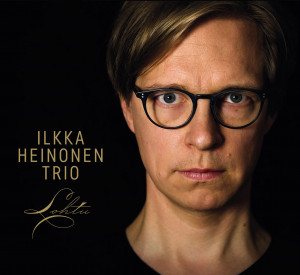 Finnish musician and composer Ilkka Heinonen plays the jouhikko, a bowed version of the kantele, a box lyre or zither common in Karelian dance music of Finland and Russia. In this album Lohtu (Solace) he has made a recording that reflects the anxiety of our time, grappling with the numbing ennui of pandemic isolation in the short term while struggling with the long-term collective consequences of ongoing climate change.
Finnish musician and composer Ilkka Heinonen plays the jouhikko, a bowed version of the kantele, a box lyre or zither common in Karelian dance music of Finland and Russia. In this album Lohtu (Solace) he has made a recording that reflects the anxiety of our time, grappling with the numbing ennui of pandemic isolation in the short term while struggling with the long-term collective consequences of ongoing climate change.
This is the sophomore release for the trio following Savu (Smoke) in 2017. With bassist Nathan Riki Thomson and percussionist Mikko Hassinen, Heinonen blends early and classical music with the improvisational methods of Nordic style jazz. The effect is by turns somber, fretful, and alarming, but never less than fascinating.
Some of the album’s nine tracks are startling works of near genius. The nearly 10 minute long “Tundra” seems to me the album’s centerpiece – Heinonen’s meditation on the inevitable melting of the tundra and its consequences. In the album’s notes, Heinonen says “Tundra” was inspired equally by Olivier Messiaen’s haunting holocaust masterpiece Quartet for the End of Time, as well as by traditional Karelian laments. In the opening rubato section, the jouhikko plays a mournful melody over a bed of deep droning bass and portentous percussion. It moves seamlessly into a section of thudding and cracking polyrhythmic percussion and syncopated plucked bass with long droning notes on the jouhikko, calling to mind the iterative music of Swiss pianist Nik Bartsch. That gives way to a brief coda with twittering, skittering synth sounds, before the jouhikko re-enters with an elegiac, fading recap of the opening tune.
The first and third tracks are companion pieces, or so it seems to me. The album opens with “Narrien kruunajaiset (Fools’ Coronation),” which is followed (after a brief pop interlude) by “Tuonelan häät (Underworld Wedding).” The former is otherworldly and a little scary, beginning with a fanfare and march inspired by French Baroque opera, and reflecting Heinonen’s feelings about the dangerous absurdity of today’s worldwide populist political situation; it then becomes a shambolic Karelian march with a bit of reverb and other effects added to the jouhikko plus clattering percussion and electronics and thudding bass from Thomson’s giant ilimba (Tanzanian thumb piano). Track 3, “Underworld Wedding,” is a sourly sweet wedding waltz, its off-kilter melody on jouhikko offset with thudding percussion, lumbering bowed bass and sinisterly cheerful glockenspiel. In Heinonen’s words, it is: ” … a bastard son of a baroque gigue and zhok, a slow klezmer dance. Imagine an Eastern European 18th century Jewish musician trying to recall Bach’s solo cello suites with a jouhikko. During the arrangement process I was imaging a scene, where the modern time dictators are dancing cheek to cheek at their wedding, and we are all forced to watch.” The piece grows more strident, dissonant and sinister as it progresses – or regresses, which is all dictators know how to do.
The album’s sequencing is masterful, with a couple of more upbeat pieces interspersed as needed breaks from the post-modern gloom. The first is the second track “Marie.” It’s a lightly loping airy pop ballad dedicated to the late Marie Fredriksson, singer in the Swedish pop duo Roxette. Vocalist Maija Kauhanen’s yoik-adjacent wordless vocals sometimes double the jouhikko melody line and sometimes soar above it. And then after the slow trauma of “Tundra” we get the galloping drums and rapid fiddling of “Varjojen Trepatska (Trepak of the Shadows),” a mainly improvised work that’s based on traditional Karelian dance tunes.
If Hector Berlioz were alive today, I like to think he’d be making music like “Vimma (Frenzy),” which after opening with frenzied octave-leaping arpeggios, moves into an EDM-adjacent track, Heinonen’s jouhikko tearing up the scenery over a sinister and equally frenzied electro beat. “Haje (Entropy),” a compilation of improvisations that distills the album’s essence, is the least tuneful track – it explores the album’s gloomy subject matter through the lens of the fusion explorations of Miles Davis and others in the late ’60s and early ’70s.
Heinonen sums up the album’s ethos in his notes:
The working title of the album Finis temporum describes the album idea aptly. Anxiety about climate change was becoming unbearable and the menacingly eroded appreciation of democracy, human rights and knowledge around the world made me feel very inconsolable – especially when I thought about the (dark) future of my own children. There was an urge to create an entity that could portray the grotesque inconsolability of our time and at the same time could give comfort and even a little hope.
The album ends with two pieces that perfectly reflect that meditation. “Valitus (Lament)” is an aptly titled solo jouhikko work, which ends with a long section of wordless wailing by Heinonen. The closing track “Lohtu (Solace)” is a slow, stately, sad march of strings, bass and drums, which to me seems to offer not exactly hope but truly solace, as from someone who comes along side to mourn with you and offer you the balm of companionship.
Lohtu (Solace) is one of the best recent examples I know of music that fulfills the purpose of art, to comfort the afflicted and afflict the comfortable.
(Nordic Notes / RockAdillo Records, 2021)
